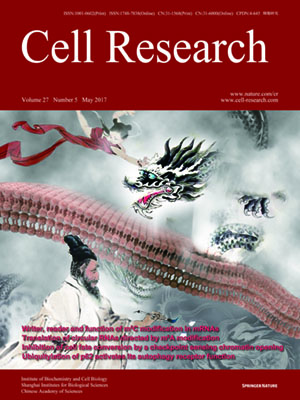
Volume 27, No 5, May 2017
ISSN: 1001-0602
EISSN: 1748-7838 2018
impact factor 17.848*
(Clarivate Analytics, 2019)
Volume 27 Issue 5, May 2017: 713-716 | Open Access
LETTERS TO THE EDITOR
Live cell single molecule-guided Bayesian localization super resolution microscopy
Fan Xu1,2,4,*, Mingshu Zhang2,3,*, Wenting He2,3, Renmin Han1,4,5, Fudong Xue2,3,4, Zhiyong Liu1, Fa Zhang1, Jennifer Lippincott-Schwartz6 and Pingyong Xu2,3,7
1Key Lab of Intelligent Information Processing, Institute of Computing Technology, Chinese Academy of Sciences, Beijing 100190, China;
2Key Laboratory of RNA Biology, Institute of Biophysics, Chinese Academy of Sciences, Beijing, 100101, China;
3Beijing Key Laboratory of Noncoding RNA, Institute of Biophysics, Chinese Academy of Sciences, Beijing, 100101, China;
4Graduate School of the Chinese Academy of Sciences, University of Chinese Academy of Sciences, Beijing 100049, China;
5Present address: Computational Bioscience Research Center, Computer, Electrical and Mathematical Sciences and Engineering Division, King Abdullah University of Science and Technology, Thuwal, 23955-6900, Kingdom of Saudi Arabia;
6Janelia Research Campus, Howard Hughes Medical Institute, Ashburn, Virginia, 20147, USA;
7College of Life Sciences, University of Chinese Academy of Sciences, Beijing, 100049, China
Correspondence: Fa Zhang, E-mail: zhangfa@ict.ac.cn; Jennifer Lippincott-Schwartz, E-mail: lippincj@mail.nih.gov; Pingyong Xu,(pyxu@ibp.ac.cn)
Many current super resolution (SR) microscopic techniques 1,2,3,4,5,6 have been successfully applied to image cellular dynamics in living cells, but their applications have remained technically challenging. Live cell stimulated emission depletion (STED)/reversible saturable optical linear fluorescence transitions (RESOLFT) microscopy and structured illumination microscopy (SIM)/nonlinear SIM require sophisticated expensive optical setups and specialized expertise for accurate optical alignment. Live cell photo-activated localization microscopy (PALM)/stochastic optical reconstruction microscopy (STORM) use less complicated setup; however, a scientific complementary metal-oxide-semiconductor (sCMOS) camera, whose pixel-dependent noise must be characterized and calibrated before use 7, is required for extremely high acquisition speed over tens of thousands of frames. Recently, wide field-based SR microscopies have been developed to improve temporal resolution using much fewer time-lapse images (hundreds to thousands) than PALM/STORM 8,9. One of them, Bayesian analysis of the blinking and bleaching (3B) 8, offers enormous potential to resolve ultrastructure and fast cellular dynamics in living cells beyond the diffraction limit. Despite its potential, 3B analysis is impractical when imaging the nanoscale dynamics in large fields of view over long time periods, as the calculation is extremely time-consuming 8 and/or the analysis consumes large amounts of web resources 10. Another major problem of 3B imaging is the artificial thinning and thickening of structures both in simulated image data and in experimental data 8,10.
10.1038/cr.2015.160
FULL TEXT | PDF
Browse 1778


